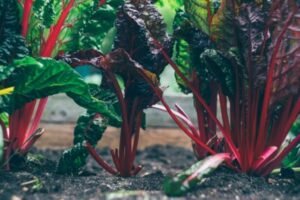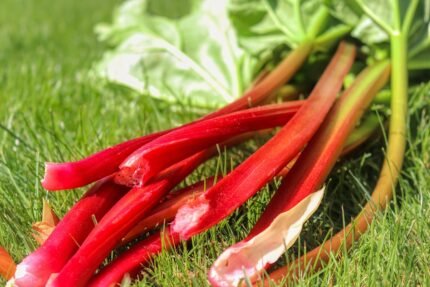Medically reviewed by Dr. Ramesh Gaddam, M.D. — Written by Sumalatha, D.N.H.E
Table of Contents
ToggleRhubarb is a unique vegetable (though often treated as a fruit in cooking) known for its tart flavor and bright red stalks. It’s often used in desserts like pies, crumbles, and jams. The leaves of the rhubarb plant are toxic due to oxalic acid, but the stalks are edible and commonly used in cooking once they’re cooked down.
Rhubarb Nutrition
The approximate nutritional values of raw rhubarb per 100 grams:
| Nutrient | Amount |
|---|---|
| Calories | 21 |
| Protein | 0.9 grams |
| Carbohydrates | 4.5 grams |
| Fiber | 1.8 grams |
| Sugars | 1.1 grams |
| Fat | 0.2 grams |
| Vitamin C | 8 mg |
| Vitamin K | 29.3 mcg |
| Calcium | 86 mg |
| Potassium | 288 mg |
Potential Benefits of Rhubarb
Rhubarb offers several potential health benefits:

Rich in Nutrients
Rhubarb is a good source of vitamins and minerals, including vitamin C, vitamin K, calcium, and potassium.
These nutrients are important for bone health, immune function, and overall well-being.
High in Fiber
Rhubarb is high in fiber, which can promote digestive health by preventing constipation and supporting a healthy gut microbiome.
Antioxidant Properties
It contains antioxidants like anthocyanins and polyphenols, which help protect cells from damage caused by free radicals.
This may reduce the risk of chronic diseases like heart disease and cancer.
Potential Blood Sugar Regulation
Some research suggests that rhubarb may help regulate blood sugar levels due to its fiber content and polyphenol antioxidants.
However, more studies are needed to confirm this effect.
Supports Weight Loss
With its low calorie and high fiber content, rhubarb can be a good addition to a weight loss diet.
Fiber helps keep you feeling full, which can aid in weight management by reducing overall calorie intake.
Anti-inflammatory Effects
Some studies suggest that rhubarb may have anti-inflammatory properties, which could benefit conditions like arthritis and inflammatory bowel disease.
Promotes Heart Health
The fiber, potassium, and antioxidants in rhubarb may contribute to heart health by lowering cholesterol levels, regulating blood pressure, and reducing the risk of heart disease.
Hydration
Rhubarb has a high water content, which can help keep you hydrated, especially when consumed in dishes like rhubarb compote or stewed rhubarb.
Uses of Rhubarb
Rhubarb is a versatile ingredient that can be used in a variety of dishes.

Here are some common uses:
Desserts
- Rhubarb Pie: A classic dessert where rhubarb is sweetened and baked in a pie crust.
- Rhubarb Crumble/Crisp: Rhubarb is topped with a crumbly mixture of flour, oats, butter, and sugar, then baked until golden and bubbly.
- Rhubarb Cake: Rhubarb can be incorporated into cakes, muffins, or cupcakes for a tangy flavor.
Preserves and Jams
- Rhubarb Jam: Rhubarb is cooked down with sugar and sometimes other fruits to create a sweet and tangy jam.
- Rhubarb Compote: Cooked rhubarb with sugar and spices, used as a topping for yogurt, ice cream, or oatmeal.
Beverages
- Rhubarb Syrup: Rhubarb syrup can be used to flavor cocktails, lemonades, or mixed with sparkling water for a refreshing drink.
- Rhubarb-Infused Spirits: Rhubarb can be infused into vodka or gin to create flavored spirits.
Sauces and Chutneys
- Rhubarb Sauce: Cooked rhubarb with sugar or honey, often served with meats like pork or chicken.
- Rhubarb Chutney: A savory-sweet condiment made with rhubarb, onions, vinegar, and spices, perfect for serving with cheeses or meats.
Salads
- Rhubarb Salad: Thinly sliced raw rhubarb can add a tangy crunch to salads, especially when paired with ingredients like strawberries, spinach, or goat cheese.
Savory Dishes
- Rhubarb Sauce for Meats: Cooked rhubarb can be used as a sauce or glaze for meats like pork or chicken.
- Rhubarb Salsa: A fresh salsa made with diced rhubarb, tomatoes, onions, cilantro, and lime juice, great for serving with grilled fish or tacos.
Baking
- Rhubarb Muffins or Bread: Incorporate chopped rhubarb into muffin or quick bread batter for a delicious treat.
Side Effects of Rhubarb
While rhubarb offers numerous health benefits, consuming it in excessive amounts or in certain forms can have potential side effects:

Digestive Issues
Rhubarb contains high levels of oxalic acid, which can contribute to digestive discomfort, including diarrhea, stomach cramps, and bloating if consumed in large quantities.
Eating raw rhubarb or consuming large amounts of rhubarb leaves, which contain higher concentrations of oxalic acid and are toxic, can exacerbate these digestive issues.
Kidney Stones
Oxalic acid in rhubarb can bind with calcium in the body to form oxalate crystals, which may contribute to the development of kidney stones in susceptible individuals.
People prone to kidney stones should limit their intake of oxalate-rich foods, including rhubarb.
Interference with Calcium Absorption
Oxalic acid in rhubarb can interfere with the absorption of calcium from other foods.
While rhubarb contains some calcium, the oxalic acid content may counteract its benefits.
Allergic Reactions
Some individuals may be allergic to rhubarb, experiencing symptoms such as itching, swelling, or hives after consuming it.
Allergic reactions to rhubarb are relatively rare but can occur.
Interaction with Medications
Rhubarb may interact with certain medications, particularly blood thinners like warfarin (Coumadin), due to its high vitamin K content.
Consuming large amounts of rhubarb while taking these medications can interfere with their effectiveness.
Electrolyte Imbalance
Consuming excessive amounts of rhubarb, especially in concentrated forms like rhubarb syrup or extract, can lead to electrolyte imbalances due to its high potassium content.
This can be particularly problematic for individuals with kidney problems or those taking medications that affect potassium levels.
Toxicity from Rhubarb Leaves
Rhubarb leaves contain high levels of oxalic acid and other compounds that are toxic to humans.
Ingesting rhubarb leaves can lead to symptoms of poisoning, including nausea, vomiting, abdominal pain, difficulty breathing, and even kidney failure.
It’s important to ensure that only the edible stalks of rhubarb are consumed and that the leaves are discarded safely.
Rhubarb Benefits for Skin
Rhubarb offers several potential benefits for the skin, primarily due to its high content of vitamins, minerals, and antioxidants:

Antioxidant Protection
Rhubarb contains various antioxidants, such as vitamin C and polyphenols, which help protect the skin from damage caused by free radicals.
Free radicals can accelerate the aging process and contribute to wrinkles, fine lines, and other signs of aging.
Anti-Inflammatory Properties
Some compounds found in rhubarb have anti-inflammatory properties, which can help soothe irritated skin, reduce redness, and alleviate conditions like acne, eczema, or rosacea.
Brightening Effects
Vitamin C in rhubarb can help brighten the skin by promoting collagen production and reducing the appearance of dark spots, hyperpigmentation, and uneven skin tone.
Regular use of rhubarb-based skincare products may help achieve a more radiant complexion.
Hydration
Rhubarb contains a significant amount of water, which helps keep the skin hydrated and plump.
Hydrated skin appears smoother, softer, and more youthful.
Exfoliation
The natural acids present in rhubarb, such as malic acid and citric acid, can gently exfoliate the skin, removing dead skin cells and promoting cell turnover.
This can result in a brighter, smoother complexion.
Wound Healing
Some traditional remedies use rhubarb extracts for wound healing due to its potential antibacterial and antiseptic properties.
However, more research is needed to confirm these effects.
UV Protection
While not a replacement for sunscreen, the antioxidants in rhubarb may offer some protection against UV-induced skin damage.
Incorporating rhubarb into your diet or skincare routine may complement sun protection efforts.
Rhubarb Benefits for Hair
While rhubarb is not typically associated with direct benefits for hair, its nutritional profile and certain properties may indirectly support hair health:

Vitamin C
Rhubarb is rich in vitamin C, which plays a crucial role in collagen production.
Collagen is essential for maintaining the structure and strength of hair strands, promoting healthy growth and preventing breakage.
Antioxidants
The antioxidants found in rhubarb, such as vitamin C and polyphenols, help protect hair follicles from damage caused by free radicals.
This protection can help maintain the health of the scalp and support optimal conditions for hair growth.
Scalp Health
Rhubarb’s anti-inflammatory properties may benefit scalp health by soothing irritation, reducing dandruff, and promoting a balanced environment for hair follicles to thrive.
Hydration
Rhubarb has a high water content, which can help keep both the scalp and hair strands hydrated.
Hydrated hair is less prone to breakage, split ends, and dullness.
Nutrient Absorption
Some nutrients found in rhubarb, such as iron and vitamins A and K, support overall health, which can indirectly benefit hair growth and strength.
Iron, for example, is important for carrying oxygen to hair follicles, promoting healthy growth.
Rhubarb Tea Benefits
Rhubarb tea, made from the dried stalks of the rhubarb plant, offers several potential health benefits:

Digestive Health
Rhubarb tea has traditionally been used to support digestive health.
It contains compounds like anthraquinones, which have laxative properties and can help relieve constipation by stimulating bowel movements.
It may also help alleviate other digestive issues like bloating and indigestion.
Antioxidant Properties
Rhubarb tea contains antioxidants like polyphenols, flavonoids, and vitamin C, which help neutralize free radicals and reduce oxidative stress in the body.
This may help protect against chronic diseases, including heart disease, cancer, and neurodegenerative disorders.
Anti-inflammatory Effects
Some compounds found in rhubarb, such as polyphenols and anthraquinones, have anti-inflammatory properties.
Drinking rhubarb tea may help reduce inflammation in the body, which can benefit conditions like arthritis, inflammatory bowel disease (IBD), and skin disorders.
Weight Management
Rhubarb tea is low in calories and can be a healthy alternative to sugary beverages.
Its natural tartness can also help curb cravings for sweet foods, making it a useful addition to a weight management plan.
Bone Health
Rhubarb contains significant amounts of calcium and vitamin K, which are essential for maintaining strong and healthy bones.
Regular consumption of rhubarb tea may help support bone density and reduce the risk of osteoporosis.
Hydration
Like other herbal teas, rhubarb tea is primarily composed of water, making it a hydrating beverage choice that can help maintain fluid balance in the body.
Liver Health
Some studies suggest that certain compounds in rhubarb may support liver health by promoting detoxification and protecting against liver damage.
Drinking rhubarb tea in moderation may help support overall liver function.
is rhubarb good for your liver?
While some research suggests that certain compounds found in rhubarb may have potential benefits for liver health, more studies are needed to fully understand its effects.

Rhubarb contains anthraquinones, such as emodin and rhein, which have been studied for their hepatoprotective (liver-protective) properties.
These compounds are believed to help promote detoxification, reduce inflammation, and protect liver cells from damage caused by toxins and oxidative stress.
Here are some potential ways rhubarb may benefit liver health:
Detoxification
Rhubarb has been used traditionally in Chinese medicine to support liver detoxification processes.
Some studies suggest that rhubarb extracts may enhance the elimination of toxins from the liver.
Anti-inflammatory Effects
Compounds in rhubarb, such as polyphenols and anthraquinones, have anti-inflammatory properties that may help reduce inflammation in the liver, which is often associated with liver diseases like hepatitis and fatty liver disease.
Antioxidant Activity
Rhubarb is rich in antioxidants, including vitamin C and polyphenols, which help protect liver cells from oxidative damage caused by free radicals.
Cholesterol Reduction
Some research indicates that rhubarb may help lower cholesterol levels, which could benefit liver health by reducing the risk of fatty liver disease and atherosclerosis.
is rhubarb good for weight loss?
Rhubarb can be a beneficial addition to a weight loss diet for several reasons:

Low in Calories
Rhubarb is naturally low in calories, with only about 21 calories per 100 grams of raw rhubarb.
This makes it a great choice for those looking to reduce calorie intake and manage their weight.
High in Fiber
Rhubarb is high in dietary fiber, with about 1.8 grams of fiber per 100 grams.
Fiber helps promote feelings of fullness and satiety, which can help reduce overall calorie intake and prevent overeating.
Low in Sugar
Rhubarb is relatively low in sugar, with only about 1.1 grams of sugar per 100 grams.
Consuming foods low in sugar can help stabilize blood sugar levels and reduce cravings for high-calorie, sugary snacks.
Hydration
Rhubarb has a high water content, which can help keep you hydrated and feeling full without adding extra calories.
Staying hydrated is important for overall health and can support weight loss efforts.
Supports Digestive Health
The fiber in rhubarb also supports digestive health by promoting regular bowel movements and preventing constipation, which can be common issues when trying to lose weight.
Versatility
Rhubarb can be used in a variety of dishes, both sweet and savory, making it easy to incorporate into a balanced diet.
Whether added to salads, cooked into a compote, or baked into desserts, there are many ways to enjoy rhubarb while watching your calorie intake.
is stewed rhubarb good for you?
Yes, stewed rhubarb can be a nutritious addition to your diet when prepared without excessive amounts of sugar.
Here are some reasons why stewed rhubarb can be good for you:
Rich in Nutrients
Rhubarb is packed with essential nutrients, including vitamins C and K, calcium, potassium, and fiber.
Stewing rhubarb helps retain these nutrients, making it a healthy option.
High in Fiber
Stewed rhubarb is an excellent source of dietary fiber, which supports digestive health by promoting regular bowel movements, preventing constipation, and supporting a healthy gut microbiome.
Low in Calories
Stewed rhubarb is relatively low in calories, especially if prepared without added sugar.
This makes it a great choice for those watching their calorie intake, particularly when used as a topping or side dish.
Hydration
Rhubarb contains a high water content, which contributes to hydration and helps keep you feeling full and satisfied.
Antioxidant Properties
Rhubarb contains antioxidants such as vitamin C and polyphenols, which help protect cells from damage caused by free radicals and may reduce the risk
the risk of chronic diseases.
Blood Sugar Regulation
Despite its tart flavor, stewed rhubarb can be a good option for those watching their blood sugar levels because it is relatively low in sugar.
Additionally, the fiber in rhubarb can help slow the absorption of sugar into the bloodstream.
Versatile
Stewed rhubarb can be used in various ways, such as a topping for yogurt or oatmeal, as a filling for pies or crumbles, or simply enjoyed on its own.
Its versatility makes it easy to incorporate into a balanced diet.
Summary:
To maximize the health benefits of stewed rhubarb, it’s best to limit the amount of added sugar.
You can sweeten it with natural sweeteners like honey or maple syrup, or use spices like cinnamon or ginger to enhance the flavor without adding extra sugar.
Additionally, avoid overcooking rhubarb, as this can lead to a loss of nutrients.
Frequently Asked Questions
Some users asked questions frequently about Rhubarb are:
Who should not eat rhubarb?
Rhubarb contains oxalic acid, which can be harmful in large quantities.
People with a history of kidney stones, kidney disease, or certain gastrointestinal conditions may need to avoid rhubarb or consume it in moderation.
Additionally, pregnant women should avoid rhubarb leaves due to their toxicity.
Does rhubarb affect blood pressure?
There is no strong evidence to suggest that rhubarb directly affects blood pressure.
However, its high potassium content may have a mild impact on blood pressure regulation.
Potassium is known to help counteract the effects of sodium on blood pressure.
Is rhubarb OK for kidneys?
While rhubarb is generally safe for healthy individuals when consumed in moderation,
people with kidney disease or a history of kidney stones should be cautious due to its oxalic acid content.
Excessive intake of oxalates can contribute to kidney stone formation.
What is rhubarb called in India?
In India, rhubarb is not commonly cultivated or known by a specific name.
It may be referred to as “rhubarb” or simply described as a type of tart vegetable.
Can I eat raw rhubarb?
While the stalks of rhubarb are edible when cooked,
the leaves are toxic and should not be consumed raw or cooked.
Raw rhubarb stalks are safe to eat, but their tart flavor may be unpleasant for some people.
Cooking rhubarb helps to soften its texture and enhance its flavor.
What are the side effects of rhubarb root?
Consuming rhubarb root or large quantities of rhubarb may cause digestive issues such as diarrhea, abdominal cramps, and bloating due to its laxative properties.
Rhubarb root should be used with caution and under the guidance of a healthcare professional.
Can you get rhubarb in India?
Rhubarb is not widely cultivated or available in India.
It is more commonly found in regions with temperate climates, such as Europe and North America.
However, some specialty stores or international markets in India may carry imported rhubarb.
How much rhubarb per day?
There is no specific recommended daily intake of rhubarb.
However, moderation is key due to its oxalic acid content.
A serving of cooked rhubarb a few times a week is generally considered safe for most people.
What to use instead of rhubarb?
If rhubarb is not available,
you can use other tart fruits such as cranberries, sour cherries, or tart apples in recipes that call for rhubarb.
These fruits can provide a similar flavor profile in dishes like pies, crisps, and sauces.
What color is Indian rhubarb?
Indian rhubarb, also known as Indian rhubarb root or Himalayan rhubarb, typically has a brownish-red to dark brown color.
The color can vary depending on the age and processing of the root.
Also Read:
Cherries: Benefits, Nutrition, Uses, Side Effects
Medically reviewed by Dr. Ramesh Gaddam, M.D.

General Physician, Diabetologist, and Critical Care Specialist.
Related
Discover more from Health Build-Up
Subscribe to get the latest posts sent to your email.

2 thoughts on “Rhubarb: Benefits, Nutrition, Uses, Side Effects”
Comments are closed.